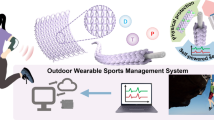Abstract
In recent years, researches on virtual fitting are mostly based on the data of garment pieces through Computer Aided Design. However, three-dimensional garment models are more intuitive, integrated and easy to access and manage. Therefore, we propose and design a method to automatically align virtual humans with three-dimensional garment models. Firstly, we basically align two models through three-dimensional geometric calculation and postural alteration of virtual humans. Then, we detect the penetration phenomena and define the points of the garment model penetrating into the human model as penetration points. Based on the penetration detection, we use Poisson mesh deformation to adjust the penetration points by imitating the adjustment process of dragging clothes. Finally, the results obtained from alignment can be directly used for physical-based simulation. Experimental results show that the method we propose can achieve good effects of alignment, and has good versatility and practicality.






















Similar content being viewed by others
References
Jiang, Y., Wang, R., Liu, Z.: A survey of cloth simulation and applications. In: Proceedings of the 2008 9th International Conference on Computer-Aided Industrial Design and Conceptual Design, pp. 765–769 (2008)
Durupynar, F., Gudukbay, U.: A virtual garment design and simulation system. In: IEEE Computer Society, pp. 862–870 (2007)
Groß, C., Fuhrmann, A., Luckas, V.: Automatic pre-positioning of virtual clothing. In: Proceedings of the 19th spring conference on Computer graphics, pp. 99–108 (2003)
Fuhrmann, A., Groß, C., Luckas, V., et al.: Interaction-free dressing of virtual humans. Comput. Gr. 27(1), 71–82 (2003)
Divivier, A., Trieb, R., Ebert, A., et al.: Virtual try-on topics in realistic, individualized dressing in virtual reality. Inform. Spektrum 27(6), 504–511 (2008)
Zhong, Y., Xu, B.: Three-dimensional garment dressing simulation. Text. Res. J. 79(9), 792–803 (2009)
Narain, R., Samii, A., O’Brien, J.F.: Adaptive anisotropic remeshing for cloth simulation. ACM Trans. Gr. 31(6), 1–10 (2012)
Zhong, Y.: Redressing three-dimensional garments based on pose duplication. Text. Res. J. 80(10), 904–916 (2010)
Guan, P., Reiss, L., Hirshberg, D.A., et al.: DRAPE: DRessing Any PErson. ACM Trans. Gr. 31(4), 13–15 (2012)
Liu, J.D., Ko, M.T., Chang, R.C.: Collision avoidance in cloth animation. Visual Comput. 12(5), 234–243 (1996)
Song, W., Yang, X.: Free-form deformation with weighted T-spline. Visual Comput. 21(3), 139–151 (2005)
Yu, Y., Zhou, K., Xu, D., et al.: Mesh editing with poisson-based gradient field manipulation. ACM Trans. Gr. 23(3), 644–651 (2004)
Tong, Y., Lombeyda, S., Hirani, A.N., et al.: Discrete multiscale vector field decomposition. ACM Trans. Gr. 22(3), 445–452 (2003)
Author information
Authors and Affiliations
Corresponding author
Rights and permissions
About this article
Cite this article
Huang, L., Yang, R. Automatic alignment for virtual fitting using 3D garment stretching and human body relocation. Vis Comput 32, 705–715 (2016). https://doi.org/10.1007/s00371-016-1236-x
Published:
Issue Date:
DOI: https://doi.org/10.1007/s00371-016-1236-x




